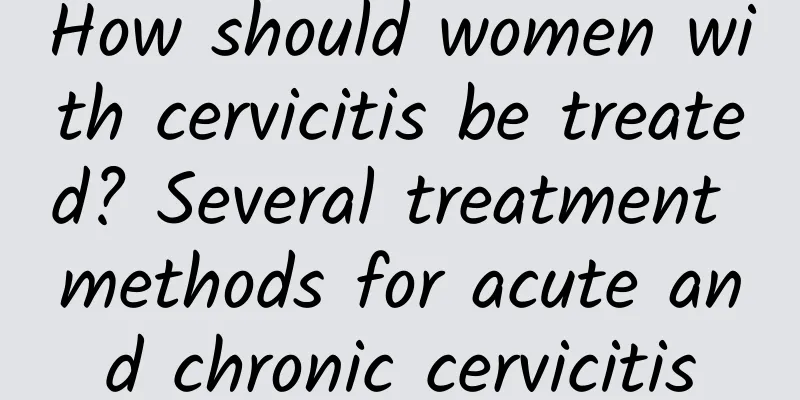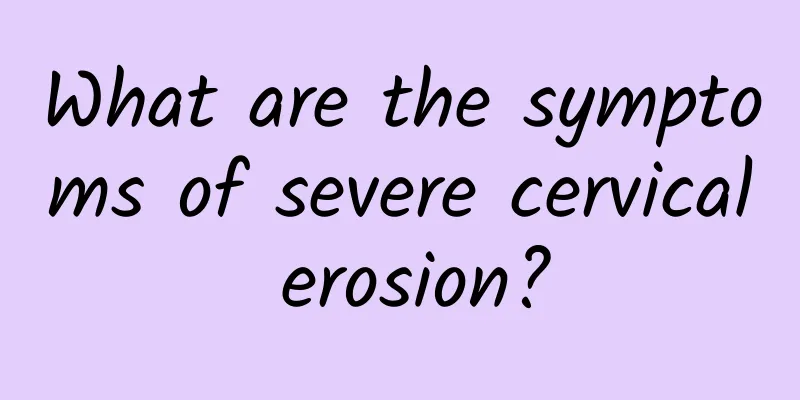How should women with cervicitis be treated? Several treatment methods for acute and chronic cervicitis

|
As we all know, if cervicitis is not cured in time in women, the inflammation site will worsen and continue to expand. Therefore, for the treatment of cervicitis, patients with cervicitis need to find and treat them in time. Next, we will tell you about several commonly used methods of treating cervicitis, hoping to help everyone. 1. Acute cervicitis The main treatment is antibiotics. (1) Empirical antibiotic treatment For patients with the following high-risk factors for sexually transmitted diseases (such as age under 25 years, multiple or new sexual partners, and unprotected sexual intercourse), empirical antibiotic treatment against Chlamydia is used before the results of pathogen testing are obtained. (2) Antibiotic treatment targeting pathogens For those who have acquired pathogens, antibiotics targeting pathogens are selected. Since Neisseria gonorrhoeae infection is often accompanied by chlamydia infection, if it is gonococcal cervicitis, in addition to the use of anti-Neisseria gonorrhoeae drugs, anti-chlamydia infection drugs should also be used during treatment. (3) Treatment of sexual partners: If the pathogens of cervicitis patients are Chlamydia trachomatis and Neisseria gonorrhoeae, their sexual partners should be examined and treated accordingly. Different treatments are used for different lesions. For those who present with erosive changes, if it is asymptomatic physiological columnar epithelial ectopy, no treatment is required. For erosive changes accompanied by increased secretions, papillary hyperplasia or contact bleeding, local physical therapy can be given, including laser, freezing, microwave and other methods. Traditional Chinese medicine treatment or its use as an adjuvant treatment before and after physical therapy can also be given. However, cervical intraepithelial neoplasia and cervical cancer must be screened out before treatment. 2. Chronic cervicitis (1) Chronic endocervical mucositis For persistent endocervical mucosal inflammation, it is necessary to check whether there is reinfection with Chlamydia trachomatis and Neisseria gonorrhoeae, whether the sexual partner has been treated, and whether the vaginal microbiome imbalance persists. Treatment should be given according to the cause. For those whose pathogens are unclear and there is no effective treatment, physical therapy can be tried. (2) Cervical polyps are treated with polypectomy, and the removed polyps are sent for pathological histological examination. (3) Cervical hypertrophy generally does not require treatment. Generally speaking, when people are looking for treatment methods for their cervicitis, they need to find out in advance whether the stage of their cervicitis is acute or chronic. Clinically, there are certain differences in the treatment methods for acute and chronic cervicitis. Therefore, patients with cervicitis must pay more attention. |
<<: How to treat female cervical erosion? Complete knowledge of female cervical erosion disease
Recommend
How big is the surgery for ovarian chocolate cyst?
How serious is the surgery for ovarian chocolate ...
What are the hazards of threatened abortion that cannot be ignored?
Female friends should know the dangers of threate...
What are the serious consequences of pelvic inflammatory disease? Need to remove the uterus
Regardless of the disease, delaying treatment wil...
Jun Ji-hyun's 4 weight loss secrets revealed! Half-body bath promotes metabolism, "this 1 trick" controls appetite
Although Korean actress Jun Ji-hyun is already 41...
Do this squat! Remember these 4 points to avoid NG
Squats work your glutes, quadriceps, hamstrings, ...
Why do women have uterine fibroids? Is uterine fibroids related to sex life?
Why do women have uterine fibroids? Uterine fibro...
What to do if your cervix is enlarged
Cervical hypertrophy is a pathological type of ch...
Will female cervical erosion turn into cervical cancer? Women should beware of three major misunderstandings about cervical cancer
Cervical cancer, a female malignancy with a secon...
You can't afford it! Hidden dangers of fat in diet
Your baby always stuffs snacks into his mouth one...
Routine diagnosis of cervical precancerous lesions
What is the basis for diagnosing cervical precanc...
How long does the stomach ache last after medical abortion? You will know after reading this
Many women experience abdominal pain after medica...
How to prevent ovarian cysts in women
At present, ovarian cysts are a common female dis...
What are the symptoms of uterine fibroids? Can uterine fibroids cause irregular bleeding?
Uterine fibroids are also a type of tumor, but th...
Is it normal to have dark brown discharge on the first day of menstruation?
Normal menstrual blood is dark red. If dark brown...
Can dysmenorrhea cause female infertility?
Nowadays, many people simply regard dysmenorrhea ...









